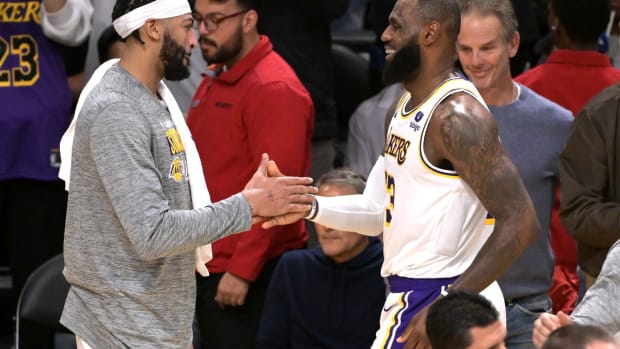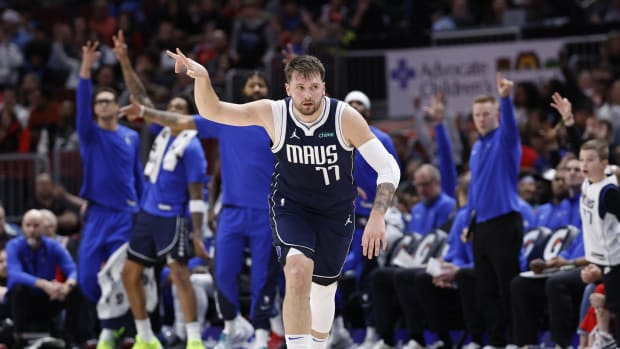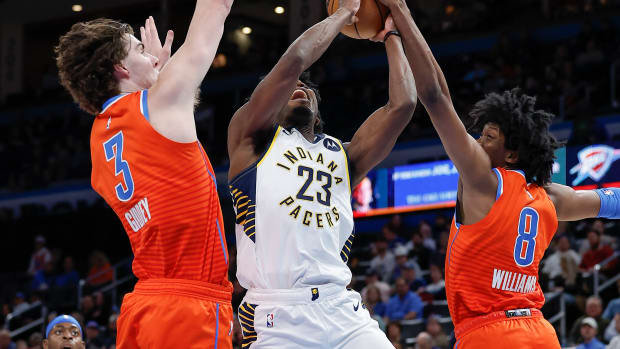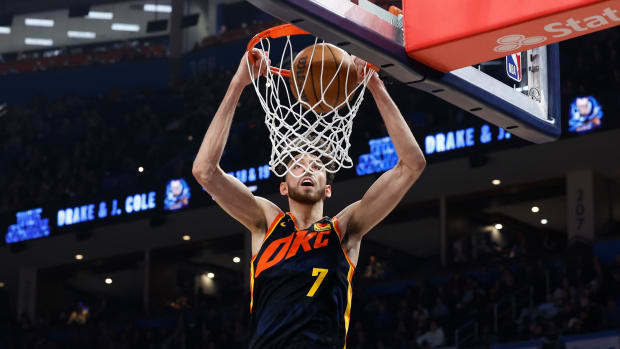14 Seconds or Less: How the NBA's New Offensive Rebound Shot Clock Has Changed Basketball
Offensive rebounds can shatter an opponent’s force of will. A five-man unit cohesively battles for 20 seconds, eliminating passing lanes and clamping ball handlers, only to force a miss and watch the loose ball trickle into the outstretched arms of an enemy. When that ricochet pings out to the top of the key and swings to a wide-open three-point shooter stationed in the corner, coaching staffs groan, arenas fall silent and momentum can completely disappear.
The Detroit Pistons feast on the offensive glass, gobbling 13.1 per game, the second-best rate in the NBA. Andre Drummond snares 6.3 each night on his own. The All-Star has poured in 111 points on put-backs—no behemoth is even within 25 of that top mark. “That’s one of our strengths,” says Pistons head coach Dwane Casey. “Andre and Blake [Griffin] do a great job tipping it in. But we have two, three things we want to do quickly.”
Detroit’s secondary options typically involve an improvised pick-and-roll, with Drummond or Griffin—whoever didn’t corral the miss—screening for a guard. Casey also wants that second-chance pinball movement, zipping around the perimeter until finding a shooter like Reggie Bullock on the weak side of the defense.
The NBA at large has seen a 2% increase in three-point rate after offensive rebounds, according to player tracking data provided to The Crossover. “In today’s NBA, scoring is at a premium,” Casey says. “The pace is way up, teams attempting the three is way up.” The league has seen a collective jump in pace to the tune of 2.9 possessions per game this season, eclipsing 100 possessions for the first time since 1988-99. That’s an astronomical leap from a year ago, considering it took teams from 2013-14 to 2017-18 to add over two possessions an outing, and it required seven seasons to boost their 91.9 league-wide pace in '06-07 to the 93.9 rate of ‘13-14. “Everyone’s playing so fast and trying to get shots up so quickly,” says Warriors head coach Steve Kerr.
Myriad factors have culminated in this presto tempo. It's no coincidence that such an upswing in pace coincided with the league’s shot clock following offensive rebounds being trimmed from 24 seconds to 14. Over the past several years, more than 90% of second-chance shots were hoisted in the first 14 seconds, according to player tracking data. With such an adaptable rule tweak, teams are launching post-offensive rebound attempts an additional 0.6 seconds faster.
With squads averaging a combined 21 offensive boards each night, that 0.6-second decrease saves 12.6 seconds of gameflow. And when teams need only 11.4 seconds to fire their first shot this season, per player tracking data, we have calculated one of the six collective extra possessions (with both clubs experiencing three greater possessions per game) teams are enjoying this year. “You just naturally go quicker,” Kerr says.
FISCHER: Why NBA Players Lob 'Grenades' to Teammates Before Time Expires
It took players a bit of time to adjust to the 14-second rule. During the Clippers’ first five games of the season, defensive stalwart Avery Bradley admits he frequently forgot about the change. “I just remember Doc screaming, ‘It’s only 14! Remember!’” Bradley says. “I was like, ‘Oh, shoot! It is only 14.” A premier perimeter defender, Bradley often finds himself guarding lead ball handlers following offensive rebounds. “Instantly, you’re thinking pick-and-roll,” Bradley says. “You really don’t have that much time. Because if the pick-and-roll doesn’t work, you’re getting into an iso situation if you can’t score out of the initial play.”
“It’s actually easier to defend,” says Rockets head coach Mike D’Antoni. And while the Rockets still rank 25th in defensive efficiency, Houston is no stranger to whirring offense. Nearly 40% of the Rockets’ attempts last season came in the first nine seconds of their possessions. “We never use the shot clock anyway,” D’Antoni crows. D’Antoni is correct about the defensive aspect, too. The quicker second-chance opportunities have actually negatively impacted three-point shooters. Players are drilling 2.5% fewer triples following offensive rebounds (compared to 0.5% higher on two-pointers). Yet most coaches maintain the 14-second change hasn’t sparked strategic offensive amendments. “When it was 24 we tried to score quickly off an offensive rebound,” Nets head coach Kenny Atkinson says. “Whether it was a kick-out three or a slice cut to the rim, it hasn’t changed our philosophy."
Dominant teams may be experiencing the truest effect of the 14-second shot clock. When Draymond Green extends a fourth-quarter Warriors possession by crashing the glass, Golden State suddenly has 10 fewer ticks it can burn toward the end of regulation. “You’re trying to milk the clock a little bit,” Kerr explains. This season, when the Warriors pace their foe by double digits with three or four minutes remaining, Stephen Curry or Kevin Durant have to immediately initiate another action. “Maybe in the past you run some clock,” Kerr says. “And now that clock goes pretty quickly.” Golden State’s nightly point differential has in fact dipped from +6.8 to +5.3. With the league’s dizzying pace leaving many defenses floundering, there are far worse problems to have.


































